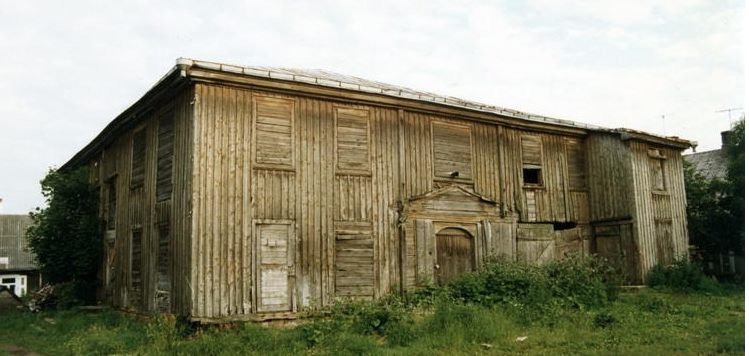The city council and mayor of Kaišiadorys, Vytenis Tomkus, are scheduled to meet with Lithuanian Jewish Community chairperson Faina Kukliansky and the community’s heritage protection specialist Martynas Užpelkis July 30 to discuss the conservation and exploitation of the Žiežmariai (Zhezhmer or Zezmer in Yiddish) Synagogue.
The Lithuanian Jewish Community in cooperation with the Cultural Protection Department has been working on how to preserve the town’s only surviving synagogue, one of the few surviving wooden synagogues in Europe, for several years now. A series of tests, studies and research including engineering and geological, archaeological, historical, building construction, timber, chemical and painting/decoration investigations, and the drafting of a detailed plan for renovation work are planned for completion this year. Restoration work beyond that, and most importantly the positive social and economic effect accruing from that, will be part of the town’s general plan for the conservation and use of heritage sites.
Cultural heritage protection Martynas Užpelkis said: “Since there are no surviving Jewish communities in many of the cities and towns of Lithuania because of the Holocaust, one of the greatest challenges is to make it so that local non-Jewish residents to accept the Jewish heritage surrounding them as an important part of ‘their’ living environment, that they would recognize it and perceive the cultural, social and economic potential in it, and that they would try to make use of the opportunities it provides. Žiežmariai is one of the Lithuanian cities which is rich in Jewish heritage sites which remain largely ‘undiscovered’ by local residents. Because of its location along the main highway between Vilnius and Kaunas and because of its urban and architectural legacy the town is already a destination for Litvak culture and history enthusiasts. It is only the rare local resident, however, who is interested in the pre-war past of the town, and local municipal institutions and business clearly have a lack of ideas on how to integrate this heritage creatively into local and regional culture, education and tourism strategies. The Nazis established a work camp inside the synagogue, from which Jews were later taken to be shot. So Žiežmariai Synagogue is a Holocaust site as well as an architectural monument.”
LJC chairperson Faina Kukliansky said she thinks the number of tourists visiting the site will increase after the unique wooden synagogue is restored and adapted for public use. One of the main thrusts of the LJC’s activities is to foster in all ways possible the continuity and growth of ethnic culture and the preservation and celebration of the Jewish cultural heritage. There are already good examples in Lithuania of synagogues which have been restored and adapted for cultural use in the cities of Kėdainiai and Joniškis, and a plan is being prepared for the restoration of the synagogue complex in Kalvarija, Lithuania.
The Žiežmariai Synagogue is the only surviving synagogue in the town. All three were ravaged by fire in 1918. In 1897 the population of Žiežmariai was 2,795, of whom 1,628 were Jews.
There is a description of the building in Lithuanian here
European Jewish Culture Days Event “The Jewish Heritage Žiežmariai: A Bridge from the Past to the Present” to Take Place September 6, 2015
The goal of the project is to make the public aware of Jewish cultural heritage sites in the city of Žiežmariai and to show their value and potential in order to encourage a holistic view of Lithuanian Jewish heritage site protection and associated conservation problems.
For more information in Lithuanian, see:
,,Žiežmarių žydų paveldas – tiltas iš praeities į ateitį”


